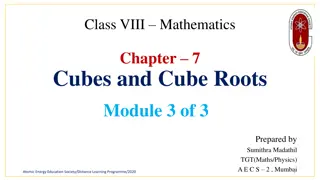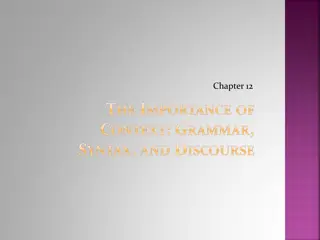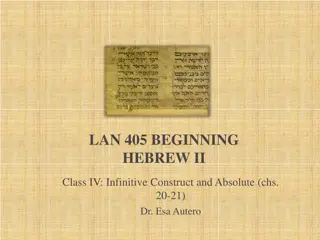Understanding Geminate Roots in Biblical Hebrew - Lesson 46 Insights
Explore the nuances of geminate roots in Biblical Hebrew through Lesson 46 insights, focusing on identifying and reading these unique verb forms. Discover how geminates conjugate erratically and learn to translate Qal yiqtol and wayyiqtol phrases, gaining a deeper understanding of their impact on scripture interpretation.
Download Presentation

Please find below an Image/Link to download the presentation.
The content on the website is provided AS IS for your information and personal use only. It may not be sold, licensed, or shared on other websites without obtaining consent from the author. Download presentation by click this link. If you encounter any issues during the download, it is possible that the publisher has removed the file from their server.
E N D
Presentation Transcript
Rocine Lesson 46 Joshua 6:15
MODULE SIX Geminates (e.g. , , ) Numbers Discourse using a qatal to set the time of a scene modal yiqtol marking peak in a discourse
Lesson 46 - Goals Identify and read geminate roots
What we already know Identify the Wayyiqtols the Qatals
What we already know Identify the Wayyiqtols the Qatals
What we already know What would the Missing Letter Rules predict for the first verb?
What we already know What would the Missing Letter Rules predict for the first verb? The qamets prefix would point to a Hollow verb. Though the dagesh forte in the bet hints that something else may be going on here, we will find that there is considerable overlap between Hollow verbs and Geminate verbs.
Qal yiqtol and wayyiqtol of geminates DEFINITION: Roots whose 2nd and 3rd letters are the same are called geminates. They conjugate erratically, often losing one of the twin root letters and showing the nikkud of a hollow verb.
Qal yiqtol and wayyiqtol of geminates Let s translate the first phrase.
Qal yiqtol and wayyiqtol of geminates Let s translate the first phrase. And they surrounded the city
Qal yiqtol and wayyiqtol of geminates Now, let s try translating the whole verse. can mean manner, custom as well as judgment. What clause boundary options do we have here in this verse?
Qal yiqtol and wayyiqtol of geminates ? ? ? To determine clause boundaries it is helpful to identify the verbs and their function.
Qal yiqtol and wayyiqtol of geminates ? ? ? The wayyiqtol is straight forward. It s the mainline for historical narrative and it starts a clause. But what options do we have for qatal? Does qatal start a clause?
Qal yiqtol and wayyiqtol of geminates ? ? ? The wayyiqtol is straight forward. It s the mainline for historical narrative and it starts a clause. But what options do we have for qatal? Does qatal start a clause? Weqatal Qatal in dependent clause X-Qatal Qatal at the start of a clause can open an Historical Narrative A clause-initial qatal often opens Historical Narrative that is within direct speech. (Rocine 26.2)
Qal yiqtol and wayyiqtol of geminates ? ? ? Masoretic cantillation ( tea'mim) is also very helpful for determining clause boundaries. Can you see where the Masoretes place the clause boundary? See What are the Accents? (Tea'mim - Cantillations) | Biblical Hebrew Q&A with eTeacherBiblical on YouTube for a nice introduction to the topic. https://www.youtube.com/watch?v=GMzawdQMb-E
Qal yiqtol and wayyiqtol of geminates Parse Root Stem Form PGN Function Root meaning
Qal yiqtol and wayyiqtol of geminates Parse Root Stem Form PGN Function Root meaning X-Qatal topicalization Qal Qatal 3cp To surround They surrounded the city according to this manner seven times. It was only on that day that they surrounded the city seven times.
Geminate morphology Geminate morphology is a bit erratic, but there are patterns as can be seen in the verb tables. For a detailed discussion of Geminate verbs see Animated Hebrew lecture 39.
Geminate morphology Geminate morphology is a bit erratic, but there are patterns as can be seen in the verb tables. For a detailed discussion of Geminate verbs see Animated Hebrew lecture 39. The best strategy for dealing with geminates is to know the commonly used roots and keep them in mind when you only see two root letters of a verb. (Rocine 46.2b., p. 256)
Common Geminates Surround Become great Be complete Measure Be desolate Lay waste Become warm Show favour Praise Make a noise Profane Begin Give a piercing cry Pray Be hostile Be evil Curse























